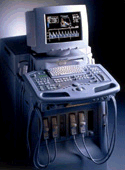Medical Ultrasound Imaging
Monday, 20 May 2024
'Ultrasound Echo' Searchterm 'Ultrasound Echo' found in 26 articles 1 term [ • ] - 7 definitions [• ] - 18 booleans [• ]Result Pages : • Ultrasound Echo
An echo is defined as the repetition of a sound by reflection of sound waves from a surface. Echo types used in ultrasound imaging: Specular echoes are created from relatively large, regularly shaped objects with smooth surfaces. Specular echoes are relatively intense and angle dependent. Scattered echoes are created from relatively small, weakly reflective, irregularly shaped objects. Scattered echoes are less angle dependant and less intense. See also Specular Echo, and Scattered Echo. • View NEWS results for 'Ultrasound Echo' (22). •  From Siemens Medical Systems;
From Siemens Medical Systems;The ACUSON Aspen™ ultrasound system resulted from a unique convergence of select ACUSON Sequoia™ ultrasound system technologies and other ACUSON innovations to form an entirely new imaging platform. Its new digital system architecture provides complete digital control of the ultrasound echoes from the transducer through the captured digital examination. Specifications for this system will be available soon. •
The amplitude is the signal height. The amplitude of the ultrasound echo is proportional to the difference of the acoustical impedance caused by different tissue layers. The amplitude decreases with increasing penetration depth of a homogeneous tissue. See also Color Amplitude Imaging. •
Correlation is a mathematical procedure, used in ultrasound to quantify the similarity between two signals. Cross correlation of successive ultrasound echoes can be used to quantify movement of tissue, including blood.
•
Echogenicity is the ability of a medium to create an echo, for example to return a signal when tissue is in the path of the sound beam. The ultrasound echogenicity is dependent on characteristics of tissues or contrast agents and is measured by calculating the backscattering and transmission coefficients as a function of frequency. The fundamental parameters that determine echogenicity are density and compressibility. Blood is two to three orders of magnitude less echogenic than tissue due to the relatively small impedance differences between red blood cells and plasma. The tissue echogenicity can be increased by ultrasound contrast agents. Encapsulated microbubbles are highly echogenic due to differences in their compressibility and density, compared to tissue or plasma. Microbubbles are 10,000 times more compressible than red blood cells. The compressibility of air is 7.65 x 10−6 m2/N, in comparison with 4.5 x 10-11 m2/N for water (on the same order of magnitude as tissue and plasma). This impedance mismatch results in a very high echogenicity. An echo from an individual contrast agent can be detected by a clinical ultrasound system sensitive to a volume on the order of 0.004 pl. See also Isoechogenic, Retrolenticular Afterglow, and Sonographic Features. Further Reading: News & More:
Result Pages : |
Medical-Ultrasound-Imaging.com
former US-TIP.com
Member of SoftWays' Medical Imaging Group - MR-TIP • Radiology TIP • Medical-Ultrasound-Imaging
Copyright © 2008 - 2024 SoftWays. All rights reserved.
Terms of Use | Privacy Policy | Advertise With Us
former US-TIP.com
Member of SoftWays' Medical Imaging Group - MR-TIP • Radiology TIP • Medical-Ultrasound-Imaging
Copyright © 2008 - 2024 SoftWays. All rights reserved.
Terms of Use | Privacy Policy | Advertise With Us
[last update: 2023-11-06 01:42:00]




